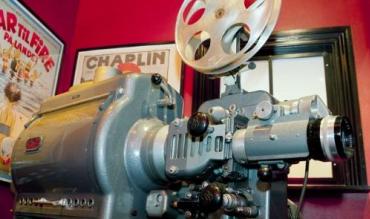Gambling and casinos have been a mainstay in the film industry nearly as long as the medium itself has been around. The drama and tension that naturally occurs in a gaming environment translates well to the silver screen and filmmakers have enjoyed taking advantage of these settings, even though it doesn’t always work out for the studio or viewers in the end.
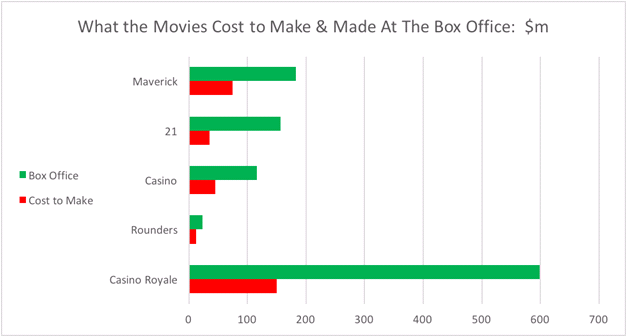
Below is a list of six casino/gambling-based movies that achieved mix results both financially and in their depiction of the gaming community. From ridiculous poker showdowns to high stakes heists, there have been no shortage of interesting gambling moments on film. But who got it right and who got it wrong? Let’s take a look.
Casino Royale
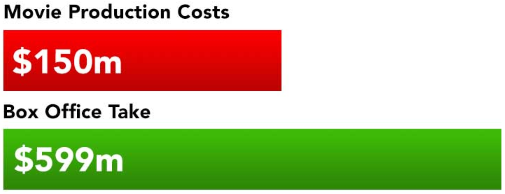
Released: November 14th, 2006
Production Cost: $150 Million
Box Office: $599 Million
Rotten Tomatoes Score: 95%
IMDB Score: 8/10
The first appearance of Daniel Craig as the titular British spy is also considered to be his best portrayal of Bond, a run that is now four movies deep. Casino Royale was able to put a fresh take on the Bond genre, focusing less on gadgets and over-the-top villains and more on gritty action and espionage. A sizable portion of the film takes place at a high-stakes poker game at the Casino Royale, where Bond and main villain Le Chiffre match wits and cards with tens of millions of dollars on the line.
The Good: Bond does a good job explaining to sexy MI6 accountant Vesper Lynd the importance in poker of recognizing tells and to play the person, not the hand. Action shown at the table is slickly shot and Craig produces a fine effort of showing Bond as a believably strong card player that shows little emotion.
The Bad: Unfortunately, most of this is undone when in the two important card showdowns both Bond and Le Chiffre always have monster hands that no one would’ve been able to prevent going all-in with, thus eliminating bluffing and any typical poker strategy from the equation. Plus, the villain shows to have a physical tell so obvious that he has to cover it up with his hand, vastly over-dramatizing the role that physical tells play in a poker game.
Did You Know: Famed director Quentin Tarantino expressed interest in directing Casino Royale and claimed that he was working behind the scenes with the family of Ian Fleming (the creator of James Bond) to make a very different movie than what finally came out. His Casino Royale would have featured previous Bond actor Pierce Brosnan, been filmed in black and white, and set in the 1950s. Angelina Jolie was the producer’s desperate first choice to play the female lead, but she responded that she would rather play the role of a female Bond instead of just “eye candy”.
Final Verdict: Great film, but stereotypical Hollywood monster poker hands prevent the poker scenes from being taken seriously.
Rounders
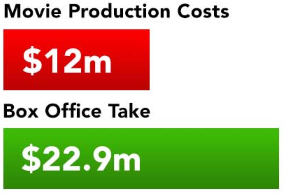
Released: September 11th, 1998
Production Cost: $12 Million
Box Office: $22.9 Million
Rotten Tomatoes Score: 65%
IMDB Score: 7.4/10
Rounders is a poker cult classic that talks about the World Series of Poker and players like Doyle Brunson and Johnny Chan years before they would all become incredibly popular due to the poker boom. The story of a small-time poker grinder named Mike (played by Matt Damon), Rounders doesn’t try to turn the character in to a massive hero that accomplishes great feats, but rather focuses on the character’s development as he tries to get his friend out of debt and build his own bankroll towards making a run at the WSOP.
The Good: Rounders has been called the best poker movie ever made by professional card player Vanessa Rousso and served as a major influence in the life of many other card sharks including Dutch Boyd, Gavin Griffin and Hevad Khan. Most of the poker scenes aren’t over the top (no one gets a royal flush), and there’s great subtle use of poker lingo that at the time most of the viewing audience would have no concept of. Rounders also shows all the different types of card games a grinder would find themselves in, such as small card rooms, restaurants, private residences, and exclusive clubs.
The Bad: Unfortunately, Rounders has a couple poker blunders that keep it from ultimate greatness. Much like in Casino Royale, the villain in Rounders, a Russian card-room owner by the name of KGB (played by John Malkovich), has a ridiculous physical tell. KGB’s tell is based around how he handles his snack cookies when making an important poker decision, a something that would be immediately obvious to any skilled poker player if stuff liked this happened in real life. It just devalues the actual poker skill level of the characters involved. Additionally, there’s a scene early on in the film where Mike correctly guesses the hands of every player sitting in a private cash game in an effort to impress them. There’s skill, and then there’s telepathy, and this accomplishment veers too far into the realm of superpowers.
Did You Know: Rounders star Matt Damon bought in to the $10,000 Main Event at the WSOP in 1998 and on the fourth day of play was knocked out when his pocket kings ran into the pocket aces of poker legend Doyle Brunson. Doyle Bruson’s poker book, “Super System”, is shown in the opening scene at the beginning of Rounders.
Final Verdict: Still my personal favorite gambling movie of all time, but it loses its edge with one too many displays of just how near-supernatural Mike’s card abilities are in certain situations and how susceptible and normal he is in other scenarios.
Casino - The Movie
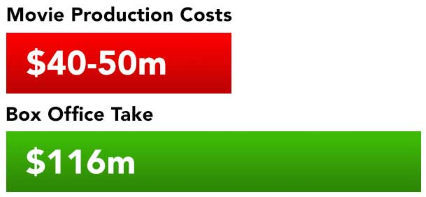
Released: November 22nd, 1995
Production Cost: $40-$50 Million
Box Office: $116 Million
Rotten Tomatoes Score: 80%
IMDB Score: 8.2/10
Long considered to be the gold standard for casino movies, Casino doesn’t show a lot of actual gambling action but paints a very vivid picture of what happens behind the scenes of a mob-era gaming establishment. Directed by Martin Scorsese and starring Robert De Niro as casino boss Sam “Ace” Rothstein, the movie has a ton of violence but if you can look past it, there are a lot of fun inside looks at the casino business.
The Good: Casino really went to great lengths to show the audience a lot about what it takes to run a giant multi-million dollar business and talks about everything from sports books, slot machines, betting percentages, odds, entertainment and more. It also covers a lot of controversial gambling topics such as cheating and the high level of punishment that was dealt out back in those days to those trying to break the rules.
The Bad: Thankfully, this classic doesn’t really cross any unbelievable lines in regards to how gambling is portrayed, making it possibly the most realistic gaming movie ever made. Everything from how money was skimmed off the top to how brutally people were removed from the face of the earth to avoid prosecution has been backed up and confirmed by historians as what really would have gone down back then. Though, we’ll go ahead and deduct one point for the lead character having the nickname of “Ace”.
Did You Know: The casino in the movie, The Tangiers, is a fictional creation made specifically for the film. However, many of the story elements come from the real life history of the Stardust Casino, one of the most famous early casinos to exist in Las Vegas. Interior shots were filmed inside the Riviera casino during the hours of 1am-4am as to not interrupt actual gamblers. A real life mob hitman who had finished his jail sentence was on set as a consultant, providing the director with information on how professional hits would have properly been handled.
Final Verdict: We’re all-in when it comes to Casino. It’s a mob classic and did an amazing job of showing the casino business as both highly exciting and highly dangerous.
Ocean’s 11
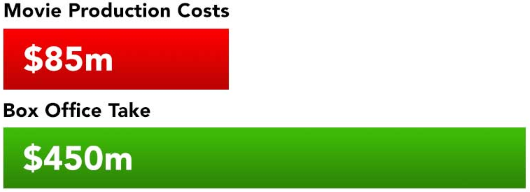
Released: December 7th, 2011
Production Cost: $85 Million
Box Office: $450 Million
Rotten Tomatoes Score: 82%
IMDB Score: 7.8/10
A remake of a movie that originally starred the Rat Pack (Sinatra, Martin, Davis, etc), Ocean’s 11 featured a modern day all-star cast that included George Clooney, Brad Pitt, Matt Damon, Julia Roberts, Don Cheadle and Andy Garcia. An extremely over-the-top heist flick, Ocean’s 11 never really takes itself seriously, which makes it a little easier to swallow the ridiculous scenarios the team finds itself in as they attempt to rob the vault of the Bellagio hotel on the night of a premier boxing match.
The Good: The cool factor is off the charts and everything about Ocean’s 11 is fun. The interior shots of the Bellagio portray a realistic concept of how the casino would operate (included the serious behavior of Terry Benedict, the casino boss played by Andy Garcia). Plus, scenes showing the day-to-day operations of one of the largest casinos in the world don’t seem out of place.
The Bad: As expected, all realism of this movie as related to the heist itself can be thrown out the window. Las Vegas casino security is legendary, and as such, pulling off a job like this would require so many moving parts that luck becomes an unfathomable factor. The characters simply needed too many “in the moment” scenarios to go their way, including situations that they couldn’t possibly plan for, and having any one of them go wrong would have derailed the entire plan.
Did You Know: Many of the main roles were originally offered to different actors. Bruce Willis was initially cast as Danny Ocean (played by George Clooney). The role of Linus, eventually played by Matt Damon, was written with Mark Wahlberg in mind. And the characters of brothers Virgil and Turk were going to be played by real life brothers Luke and Owen Wilson until they left the project to join the film The Royal Tenenbaums. Sandra Bullock has been tapped to star in an all-female reboot of Ocean’s 11.
Final Verdict: Ocean’s 11 is great fun, but it asks you to suspend far too much disbelief to think that a major Las Vegas casino could fall victim to such an epic crime. Fun, but a level of unbelievable that is only beaten by its own subsequent sequels.
21

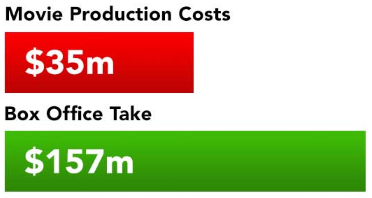
Released: March 28th, 2008
Production Cost: $35 Million
Box Office: $157 Million
Rotten Tomatoes Score: 36%
IMDB Score: 6.8/10
Based on the book “Bringing Down the House”, which tells the real life story of Jeff Ma and his fellow MIT card counters, 21 gets the same benefits from all movies that are able to borrow from events that actually happened. Most of the movie provides a near-truth, yet obviously Hollywood embellished, version of the story depicted in the book, which follows a group of math-gifted college students as they use their card counting skills to shift the blackjack odds in their favor at a number of different casinos.
The Good: 21 does an outstanding job of explaining the concept of card counting and enforces the age-old blackjack technique of “perfect strategy”, which essentially involves knowing the correct move to make (hit, stand, split, double down, etc) in any blackjack situation, thus minimizing the casino’s house advantage. The movie also correctly shows that when perfect strategy is combined with strong card counting ability, players can actually shift the percentages in their favor ever so slightly. This is the only known possible way in traditional casinos to ever have an advantage on the house.
The Bad: For all its true to real life depictions of card counting and gambling struggles, 21 suffered critically across the board from viewers for having too much of the film focus on the drama between the characters themselves and less on the actual blackjack action. Blackjack was in need of its own version of “Rounders”, but 21 did not come through to fill this void as many hoped it would.
Did You Know: The movie received negative feedback when a majority of the main roles were cast to white actors, even though nearly all of the original MIT Blackjack Team members were of Asian heritage. Additionally, many casinos declined to provide their assistance in the making of the movie, as they feared the film would provide a large general audience with the knowledge of basic card counting and inspire a new generation of card counters.
Final Verdict: Blackjack card counting doesn’t get as much love in the movies as poker does, so 21 gets somewhat of a pass for trying to break new ground. However, a lack of focus on the actual blackjack action keeps it on the rails and out of contention amongst the gambling movie greats.
Maverick
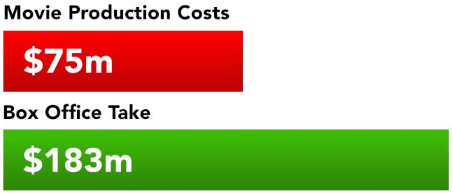
Released: May 20th, 1994
Production Cost: $75 Million
Box Office: $183 Million
Rotten Tomatoes Score: 67%
IMDB Score: 7/10
A remake of the television show of the same name, Maverick, starring Mel Gibson in the title role, follows a card playing con artist as he attempts to collect money to enter into a high stakes poker game. Maverick features a handful of interesting and fun card room scenes and even brings back the original television Maverick, James Garner, in the role of Gibson’s character’s father.
The Good: What Maverick does best from a gambling perspective is showcase what life was probably like for a traveling card shark in the 19th century, including the use of cunning, cheats, quick wit and occasionally, a gun. Enjoyable in his depiction as a charming card runner, Gibson brought a likeable characterization of Maverick to the big screen and did a commendable job of showing gambling in a positive light as opposed to the seedy portrayal it is often shown in.
The Bad: Unfortunately, Maverick is also the all-time clunker when it comes to ridiculous poker showdowns. In the final hand of the high stakes game, the three remaining players have (in order of lowest hand strength to highest) a four of a kind, a straight flush, and a royal flush. Granted, this was draw poker and not Hold’em (so no community cards were in play), but it would’ve been better if the final scene was played out in more dramatic fashion (a la The Cincinnati Kid), rather than cartoonish with a series of unbelievable hands.
Did You Know: The $25,000 buy-in for the final tournament in the movie in the 19th century would be equivalent to over $600,000 in modern times.
Ultimately, it would appear that no movie has ever perfectly captured what it’s like to be a real world card player or casino operator. Hopefully, one day we’ll see some high profile documentaries come forth that are brave enough to take on the subject matter. Until then, we’ll continue to enjoy the Hollywood gambling movies for what they are, dramatic versions of real life.
